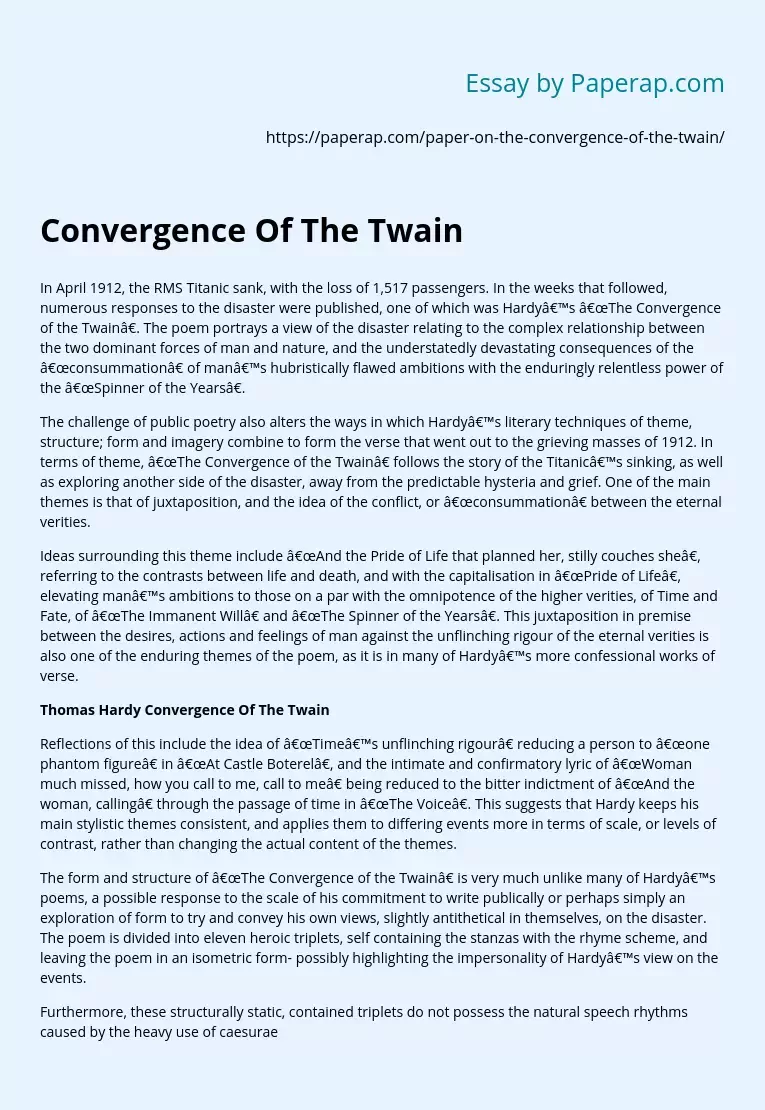Convergence Of The Twain
In April 1912, the RMS Titanic sank, with the loss of 1,517 passengers. In the weeks that followed, numerous responses to the disaster were published, one of which was Hardy’s “The Convergence of the Twain”. The poem portrays a view of the disaster relating to the complex relationship between the two dominant forces of man and nature, and the understatedly devastating consequences of the “consummation” of man’s hubristically flawed ambitions with the enduringly relentless power of the “Spinner of the Years”.
The challenge of public poetry also alters the ways in which Hardy’s literary techniques of theme, structure; form and imagery combine to form the verse that went out to the grieving masses of 1912. In terms of theme, “The Convergence of the Twain” follows the story of the Titanic’s sinking, as well as exploring another side of the disaster, away from the predictable hysteria and grief. One of the main themes is that of juxtaposition, and the idea of the conflict, or “consummation” between the eternal verities.
Ideas surrounding this theme include “And the Pride of Life that planned her, stilly couches she”, referring to the contrasts between life and death, and with the capitalisation in “Pride of Life”, elevating man’s ambitions to those on a par with the omnipotence of the higher verities, of Time and Fate, of “The Immanent Will” and “The Spinner of the Years”. This juxtaposition in premise between the desires, actions and feelings of man against the unflinching rigour of the eternal verities is also one of the enduring themes of the poem, as it is in many of Hardy’s more confessional works of verse.
Thomas Hardy Convergence Of The Twain
Reflections of this include the idea of “Time’s unflinching rigour” reducing a person to “one phantom figure” in “At Castle Boterel”, and the intimate and confirmatory lyric of “Woman much missed, how you call to me, call to me” being reduced to the bitter indictment of “And the woman, calling” through the passage of time in “The Voice”. This suggests that Hardy keeps his main stylistic themes consistent, and applies them to differing events more in terms of scale, or levels of contrast, rather than changing the actual content of the themes.
The form and structure of “The Convergence of the Twain” is very much unlike many of Hardy’s poems, a possible response to the scale of his commitment to write publically or perhaps simply an exploration of form to try and convey his own views, slightly antithetical in themselves, on the disaster. The poem is divided into eleven heroic triplets, self containing the stanzas with the rhyme scheme, and leaving the poem in an isometric form- possibly highlighting the impersonality of Hardy’s view on the events.
Furthermore, these structurally static, contained triplets do not possess the natural speech rhythms caused by the heavy use of caesurae and changes in line length that exist of many of his more personal poems. This process of technique enacting meaning leads to poems like “The Voice” and “Neutral Tones” possessing a much deeper, heartfelt message as a result of the effervescent lines, “Saying that now you are not as you were” and the heavily accented pauses that convey effect and depth- “Thus I; faltering forward/Leaves around me falling”.
This contrast in personal poetry having a more heartfelt feel and the public having a more stagnant, artificially composed nature suggests the impersonality of the public against the deeply confessional verse of the personal, and the lack of pronouns and simple lack of recognition of the dead in “The Convergence of the Twain” in contrast to the consistent “I” and “You” in the personal works adds to this feeling.
A further comment that can be made on the form of structure of “The Convergence of the Twain” is the way that tense is portrayed in the poem, and how this contributes to its effect as well as how it contrasts or identifies with Hardy’s confessional work. The “The Convergence of the Twain” has a clear division between tense, and furthermore, this division is also key to the narration of events and the dynamic aspects of the narrative.
Stanzas I-V are written entirely in the present tense, as Hardy describes the current situation of The Titanic- “Steel chambers, late the pyres/Of her salamandrine fires/Cold currents thrid, and turn to tidal lyres”- the ship itself is passive against the metaphor of the music of the “tidal lyre” sweeping over it, and the “cold currents” that employ the neologism of “thrid” to explain the meaning of their power over the once pristine ship.
This passive stasis of the poem could highlight Hardy’s indifference to the loss of those who are described as “the opulent”, or the simple fact that the ship is now at the bottom of the ocean, at the mercy of the greater forces that Hardy discusses and references with such vigour in stanzas VI-XI.
In stanza VI, the tense changes upon the heavily accentuated caesura of “Well:”, and Hardy proceeds to actively describe the events that contributed to the Titanic’s downfall- “The Immanent Will that stirs and urges everything/Prepared a sinister mate”, exemplifies this through the stanza wide enjambment highlighting the unstoppable nature of the “Will”, and the “stirs and urges” adding to dynamism of the poem.
This idea of a clear definition between tense is one that occurs much more sparsely in works of a direct importance to Hardy, as his verse of this type often blurs the boundaries between tense to highlight the distinction, or lack of distinction in his memories and the contrast and confusion between the past and present. Examples of this include lines in “The Voice”, “Saying that now you are not as you were”, and the recounting of a memory through present description in “At Castle Boterel”, “Myself and a girlish form benighted/In dry March weather.
Convergence Of The Twain. (2019, Dec 05). Retrieved from https://paperap.com/paper-on-the-convergence-of-the-twain/

